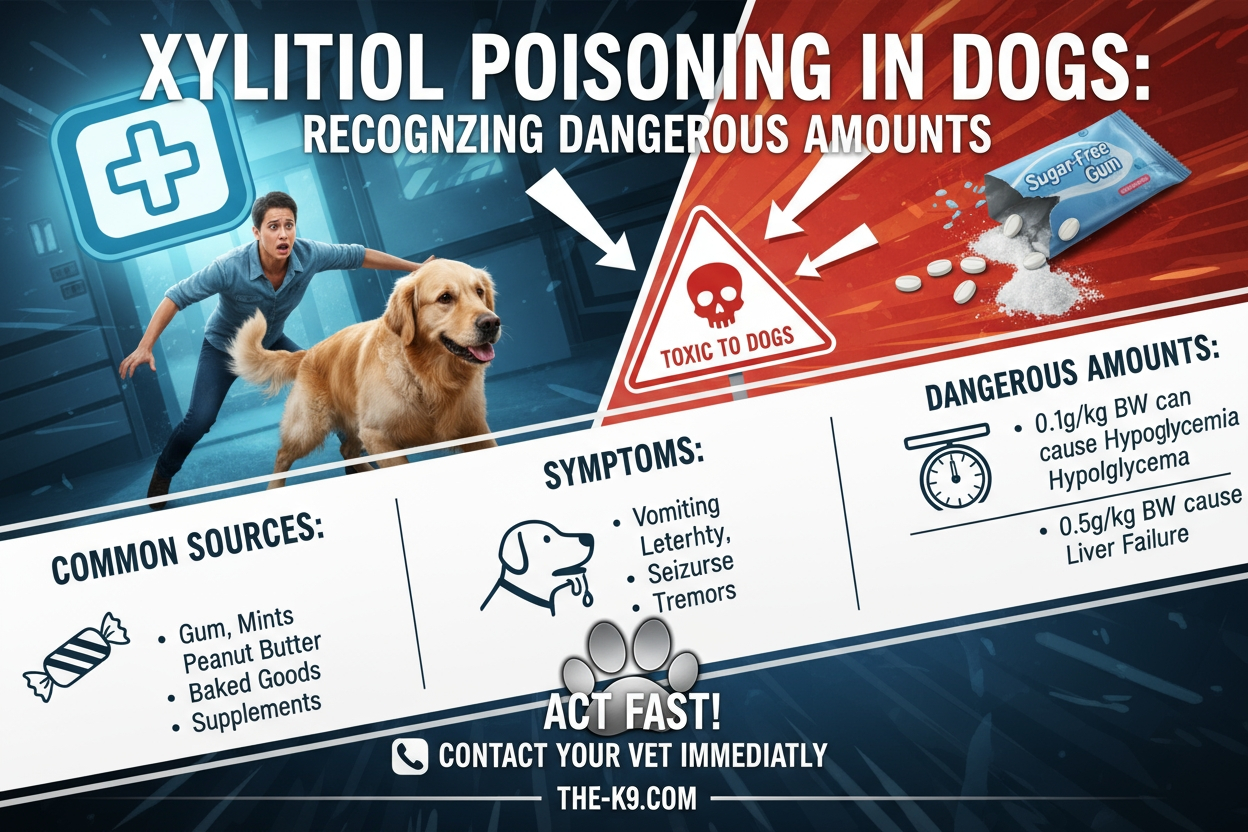Home » Xylitol Poisoning in Dogs: Symptoms & Treatment


Did you know a single piece of sugar-free gum can be deadly for your dog? Xylitol poisoning in dogs is a serious risk many pet owners don’t know about. This sugar substitute, found in many products, can cause severe health problems in dogs quickly after they eat it. Vomiting – a common first sign
Weakness and lethargy – a big drop in energy
Loss of coordination – trouble walking or staying balanced
Tremors and muscle weakness
Seizures – a sign of serious brain problems
Dog xylitol toxicity is a medical emergency that can quickly get worse. Even a little xylitol can cause big insulin spikes. This can lead to low blood sugar and even liver failure in dogs.
Pet owners need to know about xylitol risks and how to keep their dogs safe. Knowing where xylitol is and the signs of poisoning can save your dog’s life.
Xylitol is a sugar alcohol that can be harmful to pets, especially dogs. It’s found in many everyday products. Pet owners need to know where it comes from and the risks it poses.
Many household items have xylitol that dogs should avoid. Here are some common sources:
Xylitol is found naturally in some fruits and veggies. Berries, plums, and corn have small amounts. But, the amounts are usually too low to harm pets.
Pet owners should check ingredient labels carefully. Xylitol might be listed under different names. Look for these terms:
The U.S. Food and Drug Administration has seen many cases of dogs poisoned by xylitol, especially in chewing gum. Even a little can cause serious problems in dogs. Symptoms can start within 10 to 60 minutes after they eat it.
Dogs have a special reaction to xylitol that makes them different from other animals. This reaction is why sugar-free gum can be so dangerous for them. It’s a big worry for pet owners.
The main reason xylitol is so toxic to dogs is their insulin response. When dogs eat xylitol, it triggers a rapid and massive insulin release. This is something humans don’t experience. The insulin drop in blood sugar can be very dangerous, leading to hypoglycemia.
Veterinary research shows how serious xylitol poisoning is. The Pet Poison Helpline reported about 11,000 cases in 2021. This highlights the big risk to dogs’ health.
| Xylitol Dose | Potential Consequences |
|---|---|
| 0.1 g/kg body weight | Hypoglycemia risk |
| 0.5 g/kg body weight | Potential liver damage |
Dogs are especially at risk from xylitol’s toxic effects. Symptoms can start quickly, in 10 to 15 minutes. Getting to the vet fast is key to saving their life.

It’s important to know how xylitol can harm dogs. Even small amounts can be dangerous. This makes it key for pet owners to be aware and take steps to prevent it.
How bad xylitol poisoning is depends on a few things. Pet owners need to understand these factors:
The dose that can cause problems changes with the dog’s weight. Small dogs are especially at risk:
Xylitol’s harmful effects can happen fast and get worse quickly:
If you think your dog ate xylitol, act fast. Quick action can help a lot.
Xylitol poisoning in dogs can quickly go from mild to very serious. It’s key for pet owners to spot early signs to avoid severe health issues.
The first signs usually show up within 10-15 minutes after a dog eats it. Owners should look out for these important warning signs:
As xylitol poisoning gets worse, dogs can face even more serious symptoms. Blood sugar can drop fast, causing hypoglycemia. Even a tiny amount – about 0.1 grams per kilogram of body weight – can cause these dangerous reactions.
Later stages of xylitol toxicity can lead to:
Getting to the vet right away is crucial. Symptoms can get serious in as little as 30 minutes to a few hours after eating it. Quick action can greatly improve a dog’s chances of getting better.
If a dog eats xylitol, fast action is key. The risk from peanut butter with xylitol is serious. It can be deadly if not treated right away.
Act fast if you think your dog ate xylitol. Here’s what to do first:
Vets have a detailed plan to help dogs with xylitol poisoning. They make sure the dog is safe and can recover:
| Treatment Phase | Medical Intervention | Duration |
|---|---|---|
| Initial Stabilization | IV fluid administration | First 4-6 hours |
| Blood Glucose Management | Hourly glucose monitoring | 12-24 hours |
| Liver Function Support | Protective medications | 48-72 hours |
How long it takes for a dog to get better depends on how bad the poisoning is. Important steps include:
Quick treatment helps dogs get better. Vets stress the need for fast action and full care. This helps avoid serious harm from xylitol.
Keeping dogs safe from xylitol dangers is a big job. In 2021, over 401,550 pets got poisoned. It’s important to keep all xylitol products out of reach. This includes sugar-free gum, baked goods, and dental products.
Teaching everyone about xylitol dangers can help a lot. Make sure family and friends know how bad it is for dogs. Always check labels, especially on peanut butter, vitamins, and toothpaste. Use pet-safe toothpaste instead.
Kitchens and bathrooms need extra care to avoid xylitol poisoning. Set up a “pet-safe” area where harmful items are not allowed. Use locks on cabinets and drawers to keep dogs out. Regular checks can find and remove xylitol before it’s too late.
Being ready for emergencies is crucial. Keep the ASPCA Animal Poison Control Center number handy. Teach everyone what to do if a dog eats xylitol. This includes calling a vet right away.